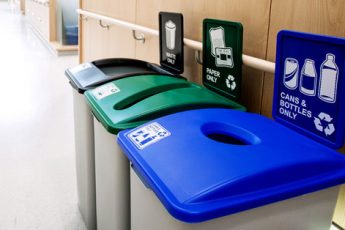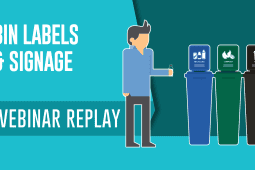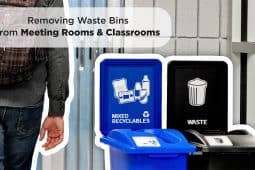Moving your organization closer to zero waste can result in cost savings, all while making a positive environmental and social impact! The goal of zero-waste is to reduce overall waste generation and to divert materials whenever possible.
The 5 R’s of Zero Waste are as follows:
• Refuse what you do not need.
• Reduce what you do need; reconsider just how much stuff you actually need.
• Reuse by repurposing stuff, or by using reusable objects like metal straws.
• Recycle what you cannot refuse, reduce or reuse.
• Rot (compost) the rest.
With these 5 R’s in mind, here are 6 creative ways you can reduce the amount of waste you generate within your organization!
1. Add a coffee machine
We’ve all been there. Late-night + early morning = a drive-thru coffee run! Not only are the single-use cups harmful to the environment, but the money spent on daily coffee can add up quite quickly. A great solution is adding a coffee machine/coffee maker within your office. Providing staff with free coffee will reduce the single-use cups in your recycling and waste streams, and just make them happier overall! It’s that simple. If you want to take it even further environmentally, opt for fair-trade coffee and packaging that is recyclable/compostable.
2. Eliminate single-use items from the office
Single-use items can fill your waste streams if you’re not careful. Putting some policies in place to remove or reduce single-use items from your organization can result in a huge cut to your waste generation. If you provide all of your employees with a mug for coffee and/or a reusable water bottle than they’ll be less likely to go out of their way to purchase a coffee or bottle of water. You can even add employee incentives for using the coffee machine/water station or for participating in zero-waste initiatives (such as packing a litterless lunch). Incentives can include gift cards, reusable swag, or anything else you can come up with! It will add some fun to the work-place and get employees excited about sustainability.
Does your organization have a kitchen? If so, see if you can pull together some reusable utensils so employees don’t use single-use cutlery or straws. Implement a few strategies, educate your team, and see your single-use numbers drop!
3. Sustainable office supplies
The number of office supplies your organization goes through can add up quickly. These items can be tricky to divert which can have a negative impact on your diversion rate. Try to choose longer-lasting office supplies when possible. Hint: choose a paper clip/binder over a stapler – because you can reuse your paper clips and paper binders but not your staples! Choose a durable binder over a flimsy folder so it stays true for longer. You can also add an office supplies’ recycling stream and have a third-party company collect them for recycling, such as Staples Canada (some locations have a box you can bring them to) or TerraCycle! There are also more eco-conscious supplies such as notebooks and pencils made from recycled content.
4. Opt to purchase less when possible
Revise your purchasing guidelines for supplies that are ethically and environmentally sourced, and give preference to equipment that will last longer and not require frequent replacement; but overall, opt to purchase fewer supplies whenever you can.
Using online bulletin boards and internal sites can reduce the need for sticky notes and note pads. Employee laptops can replace notebooks in some instances, typing over writing means fewer pens and pencils – and the list goes on!
5. Implement a Printer Policy for Reducing Paper Consumption in house
Implementing a printer policy can help you reduce the amount of paper you are tossing out, which for offices, in particular, is typically quite a lot. If you can’t go completely paperless, try to switch a few forms or processes to be completely online. Only print when you have to!
Although paper is recyclable and thus will not be adding to what you send to landfill, it is still a lot of overall waste that is generated in your company. Zero-waste should be reducing waste whenever possible, and then if not possible to divert. So less paper means less overall waste generated throughout your organization!
6. Offer recycling and organics collection, and know your programs!
And last but not least, offer recycling and organics collection! A lot of organizations have recycling in place, but far less have organics collection. Implementing organics collection allows you to divert any food waste… And hey, if you have a company garden or staff members that enjoy gardening, you can turn your organics collection into compost. Depending on your program it may also give you the chance to successfully divert materials such as coffee cups and paper towels – two common contaminants in an office setting.
Another important tip to consider: make sure that your team understands your program! They may be tossing recyclable items into the trash stream due to a lack of understanding, or just out of laziness. You can offer employee incentives and educational workshops to get staff on board and educated. As well, you can start an internal green team to take on these educational initiatives.
There you have it, 6 steps you can take to reduce waste generation and move your organization closer to zero-waste!








